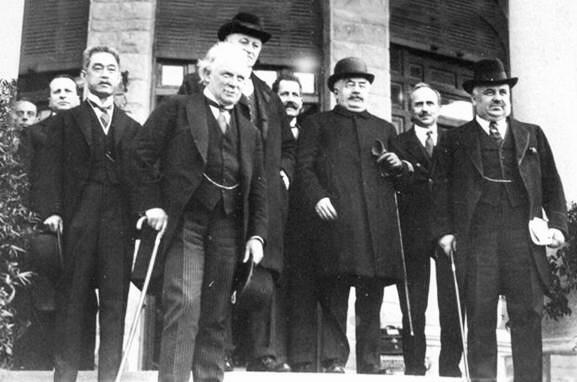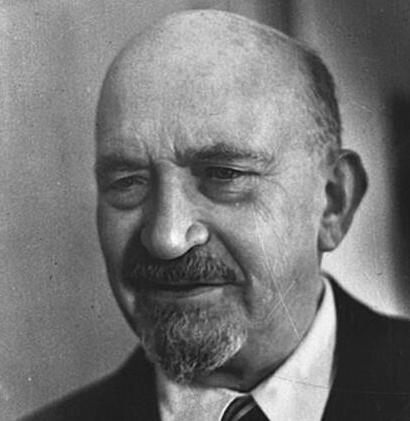Since the Oct. 7 terror attacks on Israel, media and social media have been falsifying claims that the Jewish people have no ties to Israel, no rights to Israel and that Jews are colonizers and “occupiers” of the land. These assertions, fueled by propaganda and ignorance, ignore the historical facts about the land and Jewish people.
3,400 years ago, the area of Israel was inhabited by several nomadic tribes, such as Canaanites, Amorites, Jebusites, Hittites, Philistines; however, none of those tribes exist today. What does exist today are the Jewish people and they have strong ties to the land.
2 View gallery


After the resolution on 25 April 1920, standing outside Villa Devachan, from left to right: Matsui, Lloyd George, Curzon, Berthelot, Millerand, Vittorio Scialoja, Nitti
(Photo: Unknown author - eipa.eu.com)
Archeological evidence reveals that the First Judean Temple was destroyed in 586 BCE, and with that came the Babylonian exile where Jewish civilians were dragged from their homes in chains and brought to Babylon.
Still, Jews persevered and built the Second Temple in Jerusalem, which was once again destroyed by the Romans in 70 CE, the Romans then renamed the area “Palestine”. But Judaism remained, as evidenced by the Mishnah completed in 300 CE in Tzfat, Israel, and the Yerushalmi Talmud in 500 CE in Jerusalem. Only then, in 634 BCE, did the Muslims come and add this area to the Arab Muslim Empire.
From the Spanish Inquisition, where Jews were forced to convert or be killed, to the pogroms in Russia, where Jews were raped, beaten and killed, and finally, the Holocaust, where 6 million Jews perished, the one theme throughout all these events is Jews killed for being Jewish.
From the 1800s to 1948, Jewish people bought land to allow Jewish people to return home, to a place free from harm.
In 1919, after World War II, five victorious allies — Japan, United States, Britain, Italy and France — decided what to do with the defeated territories, such as Palestine (modern-day Israel) and Germany, among many other territories. Two groups of people wanted land that belonged to the five allies. To get this land, both the Jews and the Arabs had to plead their case.
On January 3, 1919, Chaim Weizmann, leader of the Zionist movement, and Faisal, king of Saudi Arabia, met and agreed that the Arabs wanted Arab states (not including Palestine) and the Jewish people wanted Palestine.
On February 6, Arabs presented their case to the five allies, asking for recognition of Arabs under international law and a massive component of the land previously owned by the Turks. When asked about Palestine, the Arab representative presenting the case, Faisel, said that it should be left to the other signed members (the Jews).
On February 27, the Jews presented their position. Jews want recognition of the historic title of Jewish people to Palestine, not to any other territory, only Palestine, and the right to rebuild what the Jews had in Palestine in the past.
It was then that the San Remo Conference took place in Italy in 1920, where representatives of Britain, France, Italy, Japan and the U.S. convened to decide what they would do about the two cases presented to them by the Arabs and the Jews. They decided where to draw borders of what would become newly independent Arab and Jewish nation-states.
The San Remo Conference declared Palestine to be a legal entity, one that contained the areas today known as Israel, Gaza, the West Bank and Jordan (which would eventually become a nation of its own).
This resolution acknowledged the “reconstitution of the Jewish National Home in Palestine,” a nod to the indigeneity of the Jews in the area. Meanwhile, the agreement also recognized national rights for Arabs in neighboring regions of Syria, Lebanon and Iraq.
Arab representatives recognized the agreements, as well. Emir Faisal, king of Saudi Arabia, representing the Arab perspective at the conference, signed the Weizmann-Faisal agreement, which acknowledged the establishment of a Jewish homeland in Palestine. Additionally, the Emirate of Transjordan, under the leadership of Emir Abdullah, expressed willingness to work with the British Mandate authorities to implement the decisions made at San Remo.
The San Remo Conference not only realized the two-thousand-year hope of the Jewish people but also granted sovereign title to the Jewish people in the region of Palestine. The League of Nations ratified the agreement in 1922, and its successor, the United Nations, guaranteed that prior treaties be upheld in Article 80 of its charter. (It’s important to note, that as a legal agreement, this land title cannot simply be undone, revised or overridden by a UN vote. Amendments must be made by its signatories, including Israel.)
The Arab states and Israel emerged from the same historical context, making their legitimacy equally valid. Jordan – which had never been a sovereign state before – emerged as a country in 1947. That year, the British ceased their occupation of Palestine, and Israel became a state a year later.
Today, many Israelis wish to call the anniversary of the San Remo conference a national holiday. The day when Israel and its surrounding Arab neighbors were born. So for all of the rhetoric of Jews “occupying” the land, and not having sovereign title, two words aptly sum up the response: San Remo.
Sign this petition to declare Yom San Remo a national holiday, to commemorate the rebirth of Israel on her legal and historical land.
- Noa Boulakia is a student at Waterloo University and a Campus Media Fellow with Allied Voices for Israel (AVI) and HonestReporting Canada.


